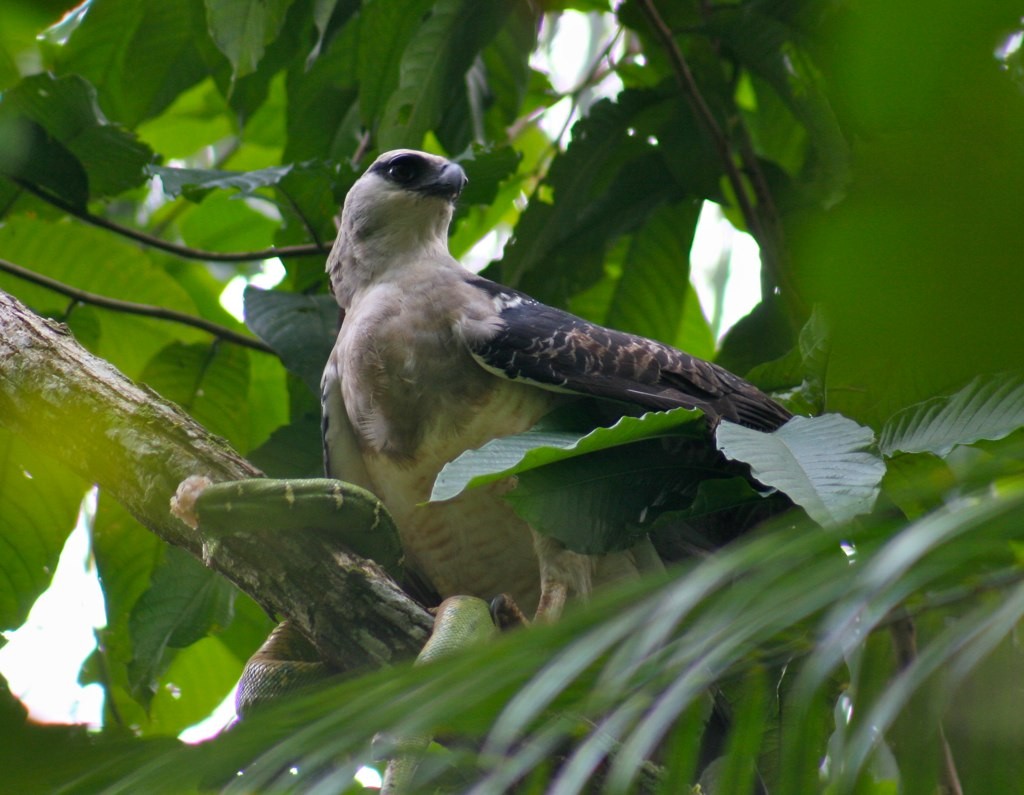Crested Eagle
A species of Crested Eagle Scientific name : Morphnus guianensis Genus : Crested Eagle
Crested Eagle, A species of Crested Eagle
Botanical name: Morphnus guianensis
Genus: Crested Eagle
Content
Description General Info
Description
This species is a large but slender eagle. It measures 71–89 cm (28–35 in) long and has a wingspan of 138–176 cm (55–70 in). A small handful of crested eagles have been weighed, entirely either males or unsexed birds, and have scaled from 1.3 to 3 kg (2.9 to 6.6 lb). Standard measurements have indicated females are about 14% larger on average than males. The crested eagle has a large head, an effect enhanced by the often extended feather crest of its name. It has bare legs, with a sizable tarsus length of 10.3 to 11.2 cm (4.1 to 4.4 in). The tail is fairly long, measuring 34 to 43 cm (13 to 17 in) in length. The wings are quite short for the eagle's size but are broad and rounded. Forest-dwelling raptors often have a relatively small wingspan in order to enable movement within the dense, twisted forest environments. The wing chord measures 42.5–48.5 cm (16.7–19.1 in). The plumage of the crested eagle is somewhat variable. The head, back and chest of most adults are light brownish-gray, with a white throat and a dark spot on the crest and a small dark mask across the eyes. There are also various dark morphs where the plumage is sooty-gray or just blackish in some cases. The distinctive juvenile crested eagle is white on the head and chest, with a marbled-gray coloration on the back and wings. They turn to a sandy-gray color in the second year of life. Dark morph juveniles are similar but are dark brownish-gray from an early age. In flight, crested eagles are all pale below except for the grayish coloration on the chest. This species often overlaps in range with the less scarce Harpy eagle, which is likely its close relative and is somewhat similar to appearance. There is evidence of an interesting interspecific relationship between and adult Crested eagle feeding a juvenile Harpy eagle in Panama, while the adult Harpy eagles were away. During these interactions, the Crested eagle brought new nesting material to the nest and in occasions brought food to the juvenile Harpy eagle. The Crested eagle is roughly half that species' bulk and is clearly more slender. Generally, Crested eagles are silent but do make a call occasionally that consists of a pair of high whistles, with the second whistle being higher pitched than the first. 
Size
89 cm
Nest Placement
Tree
Feeding Habits
Crested Eagle primarily preys on arboreal and terrestrial animals, using its keen eyesight and stealth to capture a variety of mammals and birds. Unique adaptations include strong talons for seizing prey during flight and perching on high vantage points to ambush unsuspecting animals.
Habitat
Tropical to subtropical zones in intact forests, most humid parts of contiguous, mature forest, near the coast or rivers
Dite type
Carnivorous
General Info
Feeding Habits
Bird food type
Distribution Area
It is sparsely distributed throughout its extensive range from northern Guatemala through Belize, Honduras, Nicaragua, Costa Rica, Panama, the subtropical Andes of Colombia, northeastern Venezuela, Guyana, Suriname, French Guiana, Brazil (where it has suffered greatly from habitat destruction, being now found practically only in the Amazonian basin), and east Andean Ecuador, southeastern Peru, Paraguay and eastern Bolivia to north Argentina. The crested eagle lives in humid lowland forests, mostly comprised by tropical rainforests. They can also range in gallery strips and forest ravines. Over most of the range, sightings of the species are from sea level to 600 m (2,000 ft). However, in the Andean countries, they appear to be local residents in foothill forests up to 1,000 m (3,300 ft) elevation or even 1,600 m (5,200 ft). 
Species Status
The crested eagle has always seemed to occur at low densities and may occasionally elude detection in areas where they do occur. Though they still have a large distribution, they are currently classified as Near Threatened by the IUCN. Due to their seemingly high dependence on sprawling forest, they are highly affected by habitat destruction. They are believed to no longer occur in several former breeding areas where extensive forest have been cleared. It is thought that they are occasionally hunted by local people and, in some cases, are shot on sight. If discovered while perched, they are relatively easy to shoot, since they usually perch for extended periods of time. 
